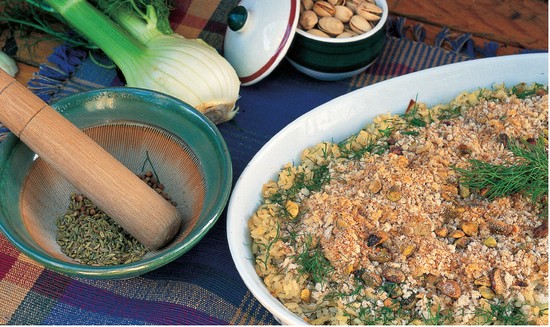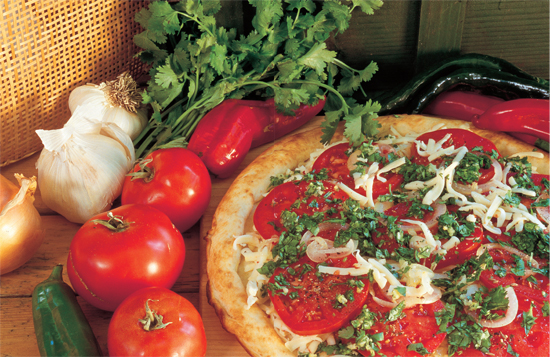
hearty vegetable dishes
sunny delight squash blossom omelet
Squash blossoms can be combined with red peppers and yellow zucchini for a colorful and especially tasty dish. Choose from Sunny Delight, Gold Rush, Golden Dawn, Sunburst, and Yellow Crookneck yellow summer squashes for the brightest colors.
For the filling:
2 tablespoons extra-virgin olive oil
1 medium red onion, thinly sliced
1 garlic clove, minced
1 medium red bell pepper, seeded and chopped
6 baby yellow and green summer squash, cut in half lengthwise
6 large squash blossoms
2 tablespoons chopped fresh basil
½ teaspoon salt
Freshly ground black pepper
For the omelet:
6 large eggs
1 teaspoon olive oil
4 tablespoons grated Parmesan cheese
Garnish: 2 tablespoons snipped fresh chives and extra whole squash blossoms
To make the filling: In a large nonstick sauté pan, heat the olive oil and sauté the onions over medium heat until soft, about 7 minutes. Add the garlic and bell peppers and cook for 5 minutes or until tender. Remove the onion mixture to a bowl and set it aside. Put the yellow and green summer squash in the same pan and sauté them until lightly browned. Combine the onion mixture with the squash in the pan.
Carefully open the squash blossoms and remove any possible critters. Remove the stamens and pistils and coarsely chop the flowers. Add the chopped blossoms and the basil to the zucchini pan, season with the salt and pepper, cover, and set aside.
To make the omelet: In a small mixing bowl, mix 3 of the eggs using a fork. In a non-stick 8- to 10-inch (20–25-cm) sauté pan, heat the olive oil until hot, but not smoking. Pour the eggs into the pan (they should sizzle). Tilt the pan in a few directions to assure that the mixture evenly coats the pan. Give the mixture a gentle shake to make sure it is not sticking. With a spatula, gently lift sections of the cooked portions and let a little of the uncooked egg flow underneath.
When most of the egg is set but the top is still moist, sprinkle 2 tablespoons of the Parmesan cheese over one half of the omelet. Spoon half of the vegetable filling over the cheese. With a spatula make sure the omelet is not sticking and then gently fold the other half of the omelet over the filling.
Slide the omelet onto a preheated plate, garnish with the chives and squash blossoms. Repeat the process for the second omelet. Serves 2.
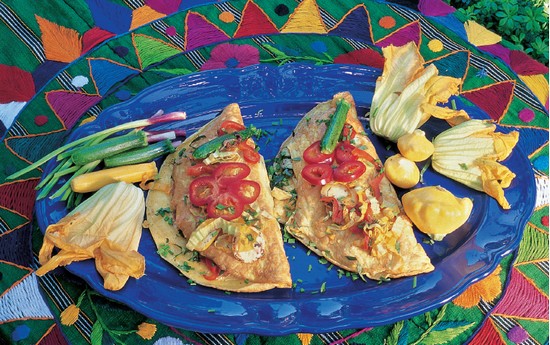
This is my favorite breakfast. I find it works best to make the tomato sauce and refried beans the day before. Not only do they taste better but when I’m still sleepy, all I have to do is assemble the dish.
For the basic tomato sauce:
6 large paste tomatoes
1 medium white onion, quartered
2 cloves garlic, unpeeled
1 to 2 serrano peppers
1 tablespoon vegetable oil
1 teaspoon salt
½ teaspoon sugar
½ teaspoon Mexican oregano
Freshly ground black pepper to taste
For the huevos rancheros:
5 cups (1 kg) refried beans (see recipe, page 34)
1 to 2 tablespoons vegetable oil
8 corn tortillas
8 eggs
Salt and freshly ground black pepper to taste
Garnish: ¼ cup (30 g) crumbled queso fresca, mozzarella, or Monterey Jack, and ¼ cup (15 g) chopped cilantro
To make the basic tomato sauce: First, peel the tomatoes by putting a cross-slit at the base of each tomato and immersing it in boiling water to expand the skin. Then immerse it in ice water to contract the meat away from the skin. Discard the skin. On a hot comal or cast-iron frying pan, toast the onion, garlic, and serranos (see page 35). Peel the garlic and remove the seeds from the serranos and the tomatoes. Put all the vegetables into a blender and purée. In a saucepan, heat the vegetable oil. Carefully add the puréed vegetables, which will splatter. Add the salt, sugar, and Mexican oregano; simmer the sauce for about 20 minutes. If the tomatoes are very acidic, add more sugar; if they are sweet, omit the sugar. Season with freshly ground black pepper.
To make the huevos rancheros: Bring the tomato sauce and the refried beans to serving temperature and keep warm. Warm your serving plates. In a nonstick frying pan over medium heat, heat the oil and cook the tortillas, one at a time, for about 30 seconds each or until the tortilla starts to puff up and soften. Drain the tortillas on a paper towel and keep them in a warm oven. Fry the eggs in the remaining oil. To serve, put two tortillas on a plate; spread them with a generous amount of tomato sauce. Place the fried eggs on top of the tomato sauce. Serve about ¾ cup (190 g) refried beans for each diner. Sprinkle the eggs with salt, pepper, and cilantro. Garnish the beans with the crumbled queso fresca. Serves 4.

These delicious, hearty pancakes get their lovely blue-green hue from the blue cornmeal and, of course, the blueberries.
¾ cup (85 g) all-purpose flour, sifted
2½ teaspoons baking powder
1 tablespoon sugar
1¼ cups (375 g) blue cornmeal
¾ teaspoon salt
1 egg
1 cup (250 ml) milk
2 tablespoons vegetable oil
1 cup (150 g) fresh blueberries
Garnish: more fresh blueberries
In a medium bowl, put the flour, baking powder, sugar, cornmeal, and salt. Blend with a spoon. In another small bowl, put the egg, milk, and oil. Mix the wet ingredients with a spoon and pour them over the dry ingredients and lightly stir until the batter is just barely moist. Fold in the blueberries.
Heat a frying pan or griddle, lightly grease it, then cook 2 or 3 pancakes at a time over medium heat until both sides are golden brown and the insides are firm. Keep the pancakes warm in a low oven until all are cooked.
Stack the pancakes and serve them with maple syrup and more fresh blueberries. Makes 8 to 10 three-inch (8-cm) pancakes.
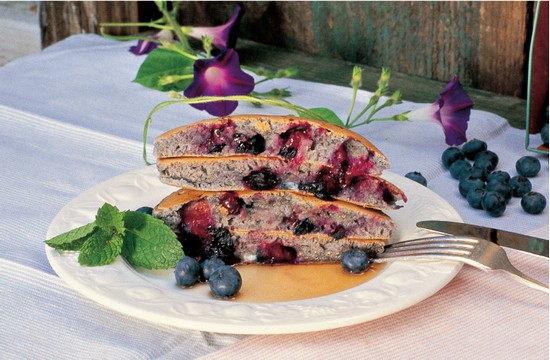
This makes a very special Mother’s Day brunch (it’s lovely with champagne) and takes full advantage of a spring flush of berries.
For the filling:
¼ lb (125 g) natural cream cheese (no gum added)
4 tablespoons strawberry yogurt
1 tablespoon powdered sugar
1 to 2 tablespoons milk
1 cup (170 g) sliced ripe strawberries
For the French toast:
4 eggs
1 cup (250 ml) milk
2 tablespoons sugar
½ teaspoon ground nutmeg
8 slices Italian bread, slightly stale
1 to 2 tablespoons unsalted butter
1 to 2 tablespoons vegetable oil
Garnish: whole strawberries
To make the filling: With an electric mixer, beat the cream cheese, yogurt, and powdered sugar until smooth and light. Slowly add the milk until the mixture is of spreading consistency. Gently fold in sliced strawberries. Cover with plastic wrap and set aside until the French toast is ready.
To make the French toast: In a shallow large bowl whisk eggs, milk, sugar, and nutmeg until blended. Soak the bread slices in this mixture for a few minutes. In a nonstick frying pan or griddle, over medium heat melt 1 tablespoon of butter. Add 1 tablespoon oil and stir to blend. Drain off any excess milk mixture from the bread slices as you remove them from the bowl and arrange them in one layer in the frying pan or griddle. Cook each slice until golden brown, turning occasionally for even browning. If you need to cook the toast in separate batches add more oil and butter for each batch and repeat the process. Keep the finished pieces warm in the oven.
Spread equal amounts of cream cheese onto 4 French toast slices and cover each with another slice of French toast, forming a sandwich. Place each serving on its own plate, cut it in half, and dust with powdered sugar. Garnish each plate with whole strawberries. Serves 4.

savory bread pudding with sorrel and baby artichokes
This unusual and complex dish combines the nutty flavors of Swiss cheese and artichokes with the lightness of sorrel, interwoven with layers of fresh herbs. It can serve as the star of the meal served with an endive or beet salad and a good red wine, or accompany filets of salmon or tuna.
1 loaf of rustic Italian bread, or about 12 slices of leftover substantial breads of all types (avoid soft sandwich-type breads, since they tend to produce a gummy dish)
1 tablespoon fresh lemon juice
1 lb (500 g) 2-in- (5-cm-) long fresh or frozen baby artichokes (approximately 18)
3 cups (750 ml) nonfat or low-fat milk
5 eggs, beaten
1 teaspoon salt
1 teaspoon pepper
¼ cup (25 g) grated Parmesan cheese, divided
4 oz (125 g) Monterey Jack cheese, slivered, divided
4 oz (125 g) Emmentaler cheese, slivered, divided
1½ cups (60 g) chopped sorrel leaves
2 tablespoons snipped fresh chives
2 tablespoons chopped fresh Italian parsley
2 tablespoons chopped fresh lemon or English thyme
1 tablespoon butter, cut into small pieces
If you’re using fresh bread, cut the loaf into 12 equal slices and arrange the slices on two cookie sheets. Bake at 200°F (95°C) for about 30 minutes, or until dry but not brown. Let the bread cool.
While the bread is in the oven, prepare the fresh artichokes. Partially fill a small bowl with water and add the lemon juice. Peel off any dried or bruised leaves from the artichokes, cut off the top ⅓ inch (1 mm) and discard it, and immediately immerse the artichokes in the lemon water to prevent them from turning brown. Place 1 inch (2.5 cm) of water in the bottom of a steamer and bring it to a boil. Drain the artichokes and put them in the steamer basket, cover, and steam them over medium heat for about 20 minutes, or until they’re just tender. Remove them from the heat and set them aside.
Break up the toasted bread slices and put them in a shallow baking dish. Pour the milk over the bread and let it soak for about 20 minutes, stirring the bread around to make sure it absorbs the milk and gets soft. After it has soaked, squeeze the milk out of the bread and set it aside. Pour the leftover milk into a measuring cup, adding more to get to ½ cup (125 ml) if necessary. In a bowl combine the ½ cup (125 ml) milk, eggs, salt, and pepper and mix well. Set aside.
Preheat the oven to 350°F (175°C). Oil a 3-quart (3-liter) casserole. Layer one-third of the bread in the bottom of the casserole. Layer two thirds of the artichokes over the bread, then layer half of the three cheeses combined and then half the sorrel and herbs. Layer another one-third of the bread, add the final one-third of the artichokes (reserve a few for the top), the last half of the sorrel and herbs, and the rest of the cheeses, reserving 3 tablespoons for the top. Top the casserole with the last one-third of the bread and the reserved artichokes. Pour the milk and egg mixture over the bread, sprinkle on the reserved 3 tablespoons of combined cheeses, and dot with butter.
Bake for about 45 minutes, or until the top is nicely browned and a knife inserted halfway into the middle comes out clean. Serve hot. Serves 4 as a hearty supper, 6 as a side dish.
Pizza can be made with dozens of different vegetables. This particular pizza includes traditional spring goodies—arugula and artichokes. I prefer a lesser amount of cheese, 6 ounces (180 g), for a lean pizza; other folks prefer their pizza “cheesy” and should use 8 ounces (250 g) of cheese.
4 baby artichokes
8 dried tomatoes
2 tablespoons extra-virgin olive oil
3 garlic cloves, minced
1 (12-in/30-cm) prebaked commercial pizza shell
6 to 8 oz (170–230 g) of fresh mozzarella cheese, sliced thin
10 black, dried, piquées or kalamata olives, pits removed
1 teaspoon fresh oregano, minced
1 cup (20 g) young arugula (rocket) leaves
¾ cup (125 g) Asiago cheese, grated
Preheat the oven to 500°F (260°C). Cut the top ½ inch (13 mm) off the baby artichokes. Cover them with water and simmer them for 10 minutes, or until tender. Cool the artichokes.
While the artichokes are cooking, chop the tomatoes coarsely and reconstitute them in warm water for 10 minutes.
Blend the olive oil with the garlic. Spread the oil mixture evenly over the pizza shell. Distribute mozzarella cheese slices evenly over the pizza shell. Quarter the cooked artichokes and put them on top of the mozzarella. Add the olives and tomatoes and sprinkle them with the oregano. Bake the pizza for 7 to 10 minutes, or until the cheese has melted. Remove it from the oven, cover it evenly with arugula, and sprinkle on the Asiago cheese.
Either serve the pizza as is or return it to the oven for 2 more minutes to wilt the arugula and melt the Asiago. Makes 1 medium-size pizza that serves 2.
penne with arugula
This is a pasta dish with complexity and a full flavor. It can be served as a pasta course or a light supper.
2 tablespoons extra-virgin olive oil
2 portobello mushrooms, sliced (about 2 cups/180 g)
3 garlic cloves, minced
6 thin slices (¼–⅓ lb/125–170 g total) prosciutto, chopped
4 paste tomatoes, peeled, seeded, and chopped (about 2 cups/400 g)
4 cups (80 g) young arugula (rocket) leaves
Freshly ground black pepper
4 cups (400 g) dried penne
4 tablespoons Asiago cheese, grated
In a deep frying pan, heat the olive oil and sauté the mushrooms over medium heat for 3 to 5 minutes, or until the mushrooms are lightly browned. Add the garlic and prosciutto and sauté for 2 more minutes. Reduce heat, add the tomatoes, and simmer for 1 more minute. Add the arugula and toss it in the pan until it has wilted, about 1 minute, then season with pepper.
Meanwhile, bring 3 quarts (3 liters) of salted water to a boil, add the penne, and cook until it’s al dente, about 6 to 9 minutes. Drain the penne. In a warm bowl, toss the penne with the vegetables, and serve with grated Asiago cheese. Serves 4 as a side dish.
fettuccine with fresh marinara sauce
This recipe calls for fettuccine, but any long noodle would work. The sauce is also great on polenta and grilled vegetables. Vary the herbs at whim—try any combination of parsley, tarragon, thyme, fennel, and anise seeds
For the sauce:
2 tablespoons extra-virgin olive oil
1 large onion, minced
3 garlic cloves, minced
1 bell pepper, roasted, peeled, and chopped
Approximately 20 paste tomatoes, blanched, peeled, seeded, and chopped (about 4 cups/800 g)
1 teaspoon chopped fresh Greek oregano
½ cup (25 g) chopped fresh basil
Salt and freshly ground black pepper
For the noodles:
1 lb (500 g) dry fettuccine noodles
¼ lb (125 g) Parmigiano-Reggiano cheese (not grated)
To make the sauce: In a pan, heat the oil and sauté the onion until transparent, about 7 minutes. Add the garlic and sauté for 3 more minutes.
Add the bell pepper, tomatoes, oregano, and basil, lower the heat, and simmer for about 25 minutes, or until the mixture is fairly thick. Salt and pepper to taste. Makes approximately 3½ cups (1 liter).
To prepare the noodles: Boil 6 quarts (6 liters) of salted water. Add the fettuccine noodles and stir them for a few seconds to keep them separated. Boil the fettuccine until just barely tender, usually about 11 minutes. Drain the noodles in a colander and immediately pour them into a warm serving bowl. Pour on the warm sauce, toss, and serve immediately. Pass the cheese with a grater so diners can serve themselves. Serves 6 to 8 for an Italian pasta course, or 4 to 6 as an American-style entrée.
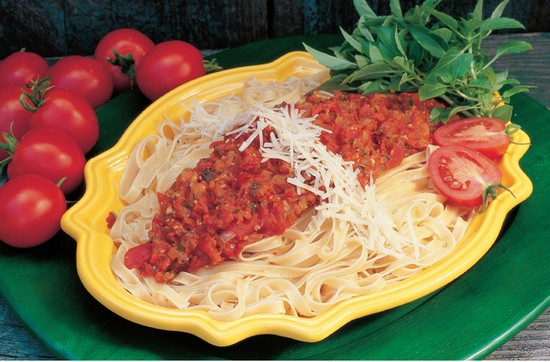
Gudi Riter, my recipe consultant, fondly remembers having this type of crunchy, succulent sandwich at the beach when she vacationed in Provence as a teenager. If you don’t have a pepper to roast or baby artichokes, substitute commercial roasted and peeled red peppers packed in olive oil and frozen or bottled marinated artichoke hearts. All are available from better grocery stores.
1 medium eggplant
2 tablespoons extra-virgin olive oil, divided
1 French baguette, crusty and rustic if possible
1 garlic clove 2 medium tomatoes, sliced
2 eggs, hard-boiled and sliced
¼ small onion, thinly sliced
3 small artichoke hearts, sliced in half
1 red pepper, roasted, peeled, and sliced
1 two-oz (60-g) can anchovies
4 to 6 leaves from heart of romaine lettuce
8 fresh basil leaves
Freshly ground black pepper
Slice the eggplant and lightly rub it with some of the olive oil. Grill it on both sides over a medium fire for 3 to 5 minutes, or until it is slightly golden and tender. Remove it from the grill and set aside.
Cut the baguette into thirds and slice each piece in half lengthwise. Under a broiler or in a toaster oven, place the bread cut-side up and toast it just enough to warm it and get it slightly crisp, about 30 seconds. Rub the garlic clove over the cut side of each piece of bread. Drizzle the slices with some of the olive oil.
To assemble the sandwiches, place the bottom pieces of bread cut-side up and layer each with tomatoes, eggs, onion slices, artichokes, eggplant, peppers, anchovies, lettuce, and basil leaves. Grind black pepper over each open sandwich half and cover the layered half with its top. Press down to secure the top to the bottom and place on a serving plate. Makes 3 sandwiches.

This spectacular tart can be served as an appetizer or as an entrée for a light lunch. It is quite dramatic made with gold tomatoes or any combination of colorful homegrown luscious tomatoes. Any leftover marinade can be used as a base for a vinaigrette dressing.
For the marinated tomatoes:
4 to 5 medium gold tomatoes, thinly sliced
6 to 7 gold cherry or pear tomatoes, halved
½ cup (125 ml) extra-virgin olive oil
1 to 2 garlic cloves, crushed
2 tablespoons chopped fresh parsley
1 tablespoon minced fresh chives
Freshly ground black pepper
For the filling:
1 cup (225 g) soft goat cheese or natural cream cheese
3 to 4 tablespoons heavy cream
1 tablespoon minced fresh rosemary
1 nine-in (23-cm) prebaked pie shell
Put both kinds of tomatoes into a bowl. In another bowl combine the ingredients for the marinade. Set aside ¼ cup (65 ml) of the marinade and pour the rest over the sliced tomatoes. Marinate them for at least 1 hour.
In a mixing bowl, combine the cheese with the cream and work them into a smooth, creamy consistency that will spread easily. Mix in the rosemary and spread the cheese mixture over the cooled pie crust.
Arrange the drained tomato slices in a single-layered circular pattern over cheese mixture, using the large slices for the outside and one slice for the middle. Fill in between the rows of large tomatoes with halved cherry tomatoes. Refrigerate until ready to serve. Just before serving, glaze the tomatoes with the remaining ¼ cup (65 ml) of the marinating mixture. Serves 6 as an appetizer.
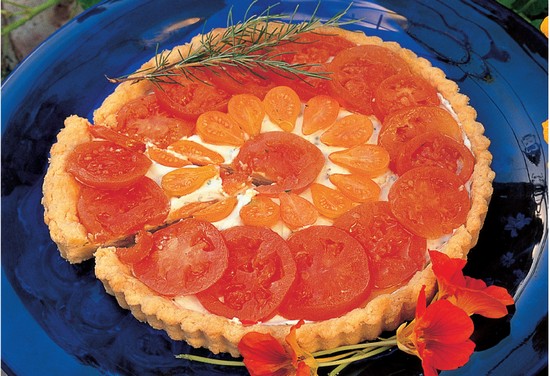
Burritos are popular in parts of northern Mexico and even more popular north of the border, especially at our house. The amounts in this recipe are a starting point—you’ll probably never make them the same way twice.
For the guacamole:
1 large ‘Hass’ or ‘Bacon’ avocado
1 teaspoon lime juice
1 to 2 teaspoons chopped fresh cilantro
Pinch of salt
Optional: 4 tablespoons fresh salsa and two dried Mexican-type avocado leaves, finely ground
For the burritos:
1½ to 2 cups (380–500 g) refried beans (see recipe on page 34)
½ to ¾ cup (80–120 g) roasted, peeled poblanos cut in narrow strips or one 4-oz (125-g) can whole green chilies
4 burrito-size flour tortillas
½ to ¾ cup (125–190 ml) fresh salsa (see recipe on page 127)
4 tablespoons guacamole
4 tablespoons sour cream
½ cup (60 g) grated jalapeño Monterey Jack cheese
Cilantro
To make the guacamole: Peel the avocado, remove the seed, and mash the flesh. Add the lime juice, cilantro, salt, and optional salsa and avocado leaves, if using. Stir the mixture well. Makes about ½ cup (250 g).
To make the burritos: Heat the refried beans. In a separate pan, heat the chilies. Keep both warm. Heat the flour tortillas on a lightly greased nonstick frying pan or comal until warm and just starting to brown. Turn each one 2 or 3 times to keep them heating evenly. To keep them warm, place them, covered with a slightly damp tea towel, in a warm oven (200°F/95°C) until you are ready to assemble the burritos.
To assemble, place one flour tortilla on a clean work surface. Place a quarter of the beans in the center of the lower half of the tortilla. Place a quarter of the chilies on top of the beans. Sprinkle a few tablespoons each of salsa and cheese and 1 tablespoon each of guacamole and sour cream over the chilies. Add a few sprigs of cilantro, if you like. Fold the bottom up and the sides in, then roll to form a burrito. Serve with the remaining guacamole. Serves 4.
Note: Use only fresh flour tortillas. Don’t let them dry out in the oven or the tortillas will crack when you try to roll them into a burrito.
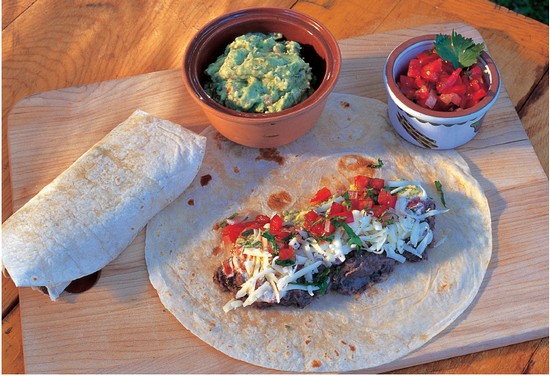
These unusually colorful tacos are best served “do-it-yourself” style. Every diner assembles their own, according to taste. See page 83 for tips on removing corn kernels form the cob.
For the guacamole:
1 ripe avocado
1 teaspoon fresh lime juice
1 teaspoon sour cream
½ teaspoon chili powder
For the taco filling:
4 ears red or yellow sweet corn, husked
1 fifteen-oz (435-g) can black beans
½ lb (250 g) French feta cheese, sliced
1 yellow or orange bell pepper, sliced
6 leaves romaine lettuce, chopped
12 corn tortillas (one 14-oz/405-g package)
To make the guacamole: Cut the avocado in half; remove the pit and the peel. In a small bowl, mash the avocado with a fork, add the lime juice, sour cream, and chili powder. Mix until smooth and creamy. Place in a small bowl, cover with plastic wrap, and refrigerate until ready to serve.
To make the taco filling: Cook the ears of corn in the microwave on high for about 2 minutes each. With a sharp knife, cut off the kernels. Set them aside in a small bowl.
Drain the beans into a sieve; rinse them with cold water and set aside in a small bowl. Place cheese, peppers, and lettuce in separate bowls.
To make the tacos: Preheat the grill. Toast the corn tortillas on the hot grill for 10 to 20 seconds on each side. Present the guacamole, salsa, and the filling ingredients in bowls at the dining table.
Each diner should fill a tortilla with about 1 tablespoon each of guacamole, salsa, corn kernels, and the black beans, then add several small slices of feta cheese and bell pepper and the romaine and then fold them together to eat. Serves 4.
Note: Red seed corn is available from Burpee; the variety shown here is ‘Ruby Queen.’
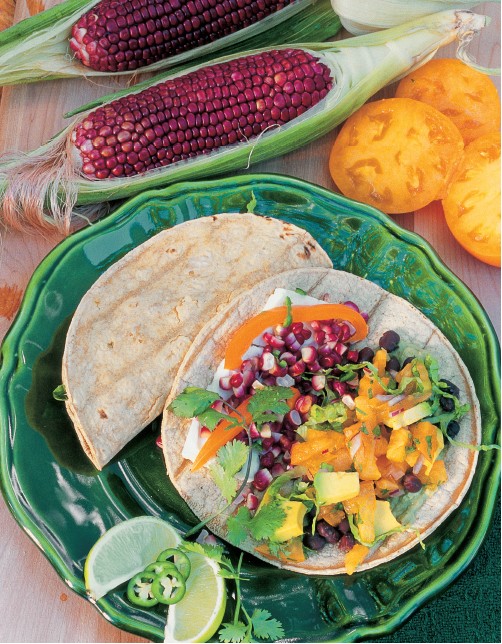
This classic dish blends the rich flavors of onions and butter. This onion tart is representative of the Alsace area of France. Slowly sautéing the onions is the secret to a rich flavor. Serve it as an appetizer or as an entrée with a soup or salad.
For the dough:
1 package (7 g) active dry yeast
½ teaspoon sugar
½ teaspoon salt
1 egg
3½ cups (390 g) of unbleached flour, divided
2 tablespoons butter, melted and cooled
1 egg yolk
For the onion filling:
2 tablespoons butter
4 to 6 medium yellow onions (about 6 cups/600 g), chopped
2 eggs
1 cup (250 ml) heavy cream
1 teaspoon (or more) caraway seeds
Salt and freshly ground black pepper
To make the dough: In a large porcelain bowl dissolve the yeast in 1 cup (250 ml) lukewarm water. Add the sugar and salt. Beat in the egg. Add 1 cup (120 g) of the flour and beat the dough until it’s smooth. Stir in the butter. Add the remaining 2½ cups (280 g) of flour to make a firm dough. Knead the dough until it’s smooth and satiny, about 20 minutes by hand. Place the dough back in the bowl, sprinkle a little flour on top, cover with a clean cloth, and let it rise for 30 to 45 minutes, or until it has doubled.
When the dough has risen, punch it down and knead it briefly to remove any air bubbles. Let it rest for 5 minutes; then roll out into a rectangle, about ¼ inch (6 mm) thick, and place on an oiled cookie sheet. Form a ½-inch (13 mm) rim around the edge of the dough. Cover the dough with cloth and let it rise for another 10 minutes. Before baking, glaze the rim with egg yolk.
To make the onion filling: In a large saucepan melt the butter and stir in the onions, cover, and cook slowly for about 15 minutes, stirring occasionally until the onions look transparent. Cool the onions to room temperature. Add the eggs, cream, and caraway seeds; season with salt and pepper to taste.
Preheat the oven to 325°F (160°C).
Fill the dough shell with the onion mixture and bake for 20 to 30 minutes or until the top is set and golden brown. Serve hot or cold. Serves 6 to 8 as an appetizer.
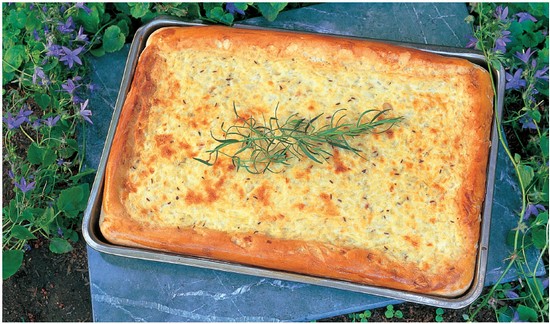
Red curry is one of the traditional dishes in Thailand. It is very spicy, and lush with coconut milk. Shrimp paste is available in Asian markets. Serve this curry over steamed rice.
For the red curry paste:
5 to 10 dried red chili peppers
1 tablespoon cumin seeds
1 teaspoon caraway seeds
20 whole black peppercorns
1 tablespoon whole coriander seeds
4 Kaffir lime leaves (fresh or dried)
3 shallots, minced
6 garlic cloves, minced
One 2½-in (6-cm) piece fresh ginger root, grated
2 stalks lemongrass, finely minced (white part only)
¼ cup (65 ml) vegetable oil
1 tablespoon fresh grated lime peel
1 tablespoon shrimp paste
For the vegetable curry:
3 carrots, peeled and thinly sliced
2 cups (120 g) snow peas, strings and stems removed
1 cup (60 g) peeled white daikon radish, cut into thin matchsticks
6 baby turnips
1 cup (175 g) broccoli, in small florets
2 cups (140 g) chopped Chinese cabbage
1 cup (70 g) tatsoi leaves
1 cup (70 g) chopped pac choi
1 cup (60 g) chopped mustard greens
¼ cup (65 ml) red curry paste (from above)
One 13.5-oz (400-g) can unsweetened coconut milk
2 teaspoons salt
1 tablespoon palm sugar or granulated sugar
4 tablespoons fresh lime juice
To make the red curry paste: Remove the stems and seeds from the chilies. Soak them in hot water for 15 minutes. Set them aside. In a dry cast-iron pan, toast the cumin seeds, caraway seeds, peppercorns, and coriander seeds over low heat until fragrant, about 3 minutes. Cool the spices and then grind together with the Kaffir lime leaves in a spice or coffee grinder until very fine.
Drain and chop the chili peppers. In a pan over low heat, sauté the chili peppers, shallots, garlic, ginger, and lemongrass in the vegetable oil until tender, about 5 minutes. Put the vegetables, ground spices, lime peel, and shrimp paste into the bowl of a food processor and process until you have a smooth paste, scraping down the sides once or twice. Stored in a sealed jar in the refrigerator, the paste keeps for about 3 weeks. Yields 1 cup (250 ml).
To make the vegetable curry: In a large pot, bring 2 quarts (2 liters) of salted water to a rolling boil. Add the carrots, snow peas, daikon, turnips, and broccoli and blanch for 2 minutes. Remove the vegetables with a slotted spoon, rinse them under cold running water to set the color and set them aside. Bring the water to a boil again and blanch the greens briefly. Drain and rinse them with cold water and set them aside with the other vegetables.
In a large pan, over low heat, sauté the curry paste for 3 minutes. Stir in the coconut milk, salt, palm sugar, and fresh lime juice. Heat the sauce but do not boil or it will curdle. Add the vegetables to the pan, toss together until well combined and adjust the seasoning. Serves 4 to 6.

This is a classic Indonesian dish and has many variations. I like this one as it contains so many vegetables. It makes a wonderful vegetarian lunch.
For the sauce:
1 cup (250 g) chunky peanut butter
3 garlic cloves, minced
3 to 5 chilies, minced
2-in (5-cm) piece fresh ginger root, grated
⅓ cup (85 ml) soy sauce
1 teaspoon sugar
1 teaspoon salt
2 Kaffir lime leaves (fresh or dried)
4 tablespoons fresh lime juice
For the vegetables:
3 cups (500 g) yard-long beans, cut in 2-in (5-cm) lengths
3 medium carrots, cut into thin match-sticks
3 cups (225 g) fresh spinach, loosely packed
3 cups (250 g) chopped Chinese cabbage
2 cups (200 g) fresh bean sprouts
3 tablespoons vegetable oil
5 oz (150 g) firm tofu
½ medium onion, thinly sliced
4 hard-boiled eggs
To make the sauce: In a pot, combine the peanut butter, garlic, chilies, ginger, soy sauce, sugar, salt, lime leaves, and 2½ cups (625 ml) water. Bring the mixture to a boil and simmer, stirring often, for 30 minutes. Cool the sauce, stir in the fresh lime juice, and reserve.
To make the vegetables: In a large pot, bring 2 quarts (2 liters) of salted water to a rolling boil. Add the yard-long beans and carrots and cook them for 2 minutes. Remove them from the cooking water with a slotted spoon, rinse with cold water, and set them aside. Bring the water to a boil again and blanch the spinach, Chinese cabbage, and bean sprouts for 30 seconds. Drain and set aside.
To serve: In a frying pan, heat the vegetable oil and fry the tofu on all sides until golden brown. Drain on a paper towel and set aside. Add the sliced onions to the same pan and fry over medium heat until golden. Drain them on a paper towel and reserve. Quarter the hard-boiled eggs. Slice the tofu ¼ inch (6 mm) thick. In a serving bowl, toss the vegetables with the peanut sauce. Garnish with the sliced tofu, the quartered eggs, and the fried onions. Serves 4 to 6.

When one thinks of stuffed peppers, bell peppers usually come to mind. All large peppers can be used, however, with one caveat: some varieties have tougher skin than others, and diners may have to remove the skins as they eat. With one simple alteration, this dish can be made as spicy as you’d like. For extra hot, use a fiery habañero pepper in the filling. For a tamer version, choose a serrano or jalapeño pepper. If you don’t like spicy foods, pick a mild poblano.
4 large or 6 medium red or yellow sweet peppers
6 ears white corn, shucked, or 2 15-oz (430-g) cans of white corn
1 tablespoon extra-virgin olive oil
1 cup (100 g) sliced scallion (green onion)
2 garlic cloves, minced
2 cups (340 g) sliced mushrooms (about ⅔ lb)
1 green bell pepper, diced
1 poblano, jalapeño, serrano, or habañero pepper (your choice: how spicy do you want them?)
2 teaspoons ground cumin
1½ tablespoons fresh oregano
1 teaspoon salt
Freshly ground black pepper to taste
3 cups (250 g) grated mozzarella cheese (½ lb)
Cut an opening into the side of each pepper and clean out the seeds and membranes. Elongated peppers should look like a canoe. Set them aside.
Preheat the oven to 325°F (160°C). Cut the kernels off the corn. You should have about 3 cups (870 g).
In a large saucepan, heat the olive oil, add the scallion, garlic, mushrooms, and peppers, and sauté for 10 minutes. Add the corn kernels, cumin, oregano, salt, and pepper, and cook for another 5 minutes. With a teaspoon, stuff the hollowed peppers. Place them close together in a greased baking dish. Sprinkle them with the mozzarella cheese and bake them for about 45 minutes. Serves 4 to 6.
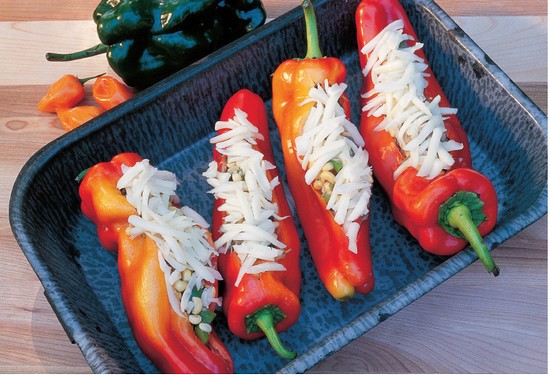
Noodles of many types are popular in Japan. I am most fond of the fresh noodles available in Asian grocery stores and usually keep some on hand. They are found in the refrigerator section and are sealed in plastic; they usually keep for a few months. Americans are most familiar with these ramen noodles in their dried form. The following is a much more satisfying dish than the dried commercial version and contains a lot more nutrition.
2 tablespoons corn oil
½ cup (70 g) chopped pickled mustard (see the recipe on page 31, or buy it in an Asian market)
1 cup (80 g) Chinese cabbage ribs, sliced
1 medium carrot, thinly sliced
1 large shallot or small onion, diced
4 cups (280 g) Chinese cabbage leaves, chopped
1¼ lbs (625 g) fresh Japanese noodles
½ cup (125 ml) chicken stock
1 tablespoon Worcestershire sauce
½ teaspoon chili powder
½ teaspoon sugar
½ teaspoon salt
Garnish: 1 sliced scallion (green onion)
In a wok, heat the corn oil over high heat. Add the pickled mustard, ribs of Chinese cabbage, and sliced carrots. Stir-fry for 2 minutes. Add the shallot and the chopped leaves of the Chinese cabbage and stir-fry 1 minute more. Toss in the noodles and cook for 2 more minutes. Add the chicken stock, Worcestershire sauce, chili powder, sugar, and salt. Cook 1 minute more to combine the flavors. Serve in a bowl garnished with sliced scallion. Serves 2.
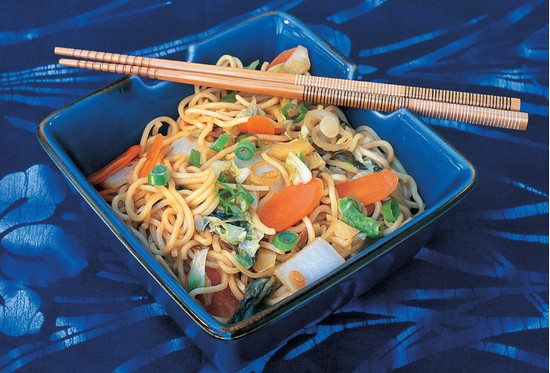
This is a rich lasagna filled with great vegetables. All it needs is a loaf of good bread and a mesclun salad to create a feast.
For the lasagna noodles:
1 lb (500 g) dried lasagna noodles
1 tablespoon extra-virgin olive oil
For the filling:
1 lb (500 g) ricotta cheese
1 egg
3 garlic cloves, minced
1 tablespoon chopped fresh oregano
¼ cup (15 g) chopped fresh basil leaves
½ teaspoon hot pepper flakes
1 cup (90 g) grated parmesan cheese
6 pimiento peppers, roasted, peeled, and seeded
1 lb (500 g) fresh spinach, large stems removed
2 cups (230 g) mozzarella cheese, grated
3½ cups (875 ml) marinara sauce
For the béchamel sauce:
2 tablespoons butter
3 tablespoons flour
2 cups (500 ml) milk
Pinch of freshly grated nutmeg
Salt and freshly ground black pepper
To cook the lasagna noodles: In a large pot of boiling salted water, cook the lasagna noodles for 9 minutes or until just tender. Drain them and separate them. Brush each lasagna noodle lightly with olive oil so they will not stick together. Set them aside.
To make the filling: In a small bowl, blend the ricotta with the egg, garlic, oregano, basil, hot pepper flakes, and 2 tablespoons of the Parmesan cheese and set aside.
Slice the roasted pimiento into strips 2 inches (5 cm) wide and set aside.
Wash the spinach. Steam the spinach until wilted, about 1 minute. Squeeze out some of the liquid and set the spinach aside.
To make the béchamel sauce: Melt the butter in a heavy saucepan. Using a wire whisk, stir in the flour. Add the milk a little at a time, while stirring. Simmer over low to medium heat until the sauce thickens, stirring constantly to avoid lumps and burning. Once the sauce thickens, cook it for 1 minute longer. Season the sauce with nutmeg, salt, and pepper.
To assemble the lasagna: Preheat the oven to 350°F (175°C). Brush the bottom of a large (14 x 9 x 2 in/35 x 25 x 5 cm) baking dish with the olive oil. Cover the bottom of the dish with a single layer of lasagna noodles. Spread the ricotta mixture over the noodles.
Cover the ricotta with the pepper slices and sprinkle with ½ cup (60 g) mozzarella. Cover with a layer of noodles. Spread the spinach over the noodles and cover with the béchamel sauce and ½ cup (60 g) more of mozzarella. Cover with a last layer of noodles, and sprinkle them with another ½ cup (60 g) of mozzarella.
Pour the marinara sauce over the lasagna. Sprinkle it with the remaining mozzarella and parmesan cheese. Bake the lasagna for 30 to 40 minutes or until the cheese is lightly browned and bubbly. Let the lasagna sit for about 10 minutes so the juices will be absorbed before serving. Cut in serving-size squares. Serves 6 to 8.
zucchini pancakes with tomato salsa
Most often, I serve these pancakes with salsa for a light supper; but for breakfast I omit the onions and serve them with maple syrup. This is a fun dish to make with children. If they want to do it all by themselves, a package of corn muffin mix works well. Follow the directions for cornmeal pancakes and add the vegetables to the wet mixture.
For the salsa:
2 yellow or orange tomatoes, chopped
2 tablespoons chopped red onion
1 small avocado, peeled, pitted, and chopped
1 teaspoon minced jalapeño pepper
1 tablespoon minced fresh cilantro
2 tablespoons fresh lime juice
2 tablespoons extra-virgin olive oil
¼ teaspoon ground cumin
⅛ teaspoon salt
Freshly ground black pepper
For the pancakes:
¾ cup (85 g) all-purpose flour, sifted
2½ teaspoons baking powder
1 tablespoon sugar
1¼ cups (190 g) yellow cornmeal
¾ teaspoon salt
1 egg
1 cup (250 ml) milk
2 tablespoons vegetable oil
1 cup (175 g) grated yellow summer squash or yellow zucchini (about 1½ medium)
3 tablespoons yellow bell pepper, seeded and chopped fine
3 tablespoons finely chopped onion
1 cup (250 ml) fresh salsa (from above), or your favorite commercial salsa
To make the salsa: In a bowl, combine the tomatoes, red onion, avocado, jalapeño pepper, and the cilantro with the lime juice, olive oil, cumin, and salt and pepper. Cover with plastic wrap and set aside.
To make the pancakes: In a medium bowl, put flour, baking powder, sugar, cornmeal and salt. Blend with a spoon. In a small bowl, put the egg, milk, oil, squash, pepper, and onion. Mix the wet ingredients with a spoon. Pour over the dry ingredients and stir lightly until just barely moist.
Heat a nonstick frying pan or griddle, then cook 2 or 3 pancakes at a time over medium heat until both sides are golden brown and the insides are firm. Keep the pancakes warm in a low oven until all are cooked. Serve the pancakes with the salsa. Makes 8 to 10 three-inch (8-cm) pancakes.
Traditional quesadillas are corn tortillas or masa folded over a cheese filling and fried. Sometimes chopped and cooked prickly pear cactus paddles or squash blossoms are added. In the Southwest, the concept has expanded, and some families (like mine) eat quesadillas day and night as either a snack or light meal and make them with both the traditional corn tortillas and flour tortillas. I find it easier to cook a sandwich quesadilla, with a bottom and a top tortilla, than the traditional folded-in-half tortilla. It’s easier to manage on the comal and I can use less-than-fresh tortillas because stale ones crack when folded.
4 corn tortillas
½ to ⅔ cup (60–80 g) crumbled queso fresca or grated plain or hot pepper Monterey Jack cheese
½ cup (70 g) roasted poblano peppers cut into thin matchsticks or canned, chopped hot peppers
Cilantro
Heat a comal, well-seasoned cast-iron frying pan, or nonstick sauté pan over fairly high heat. Place two tortillas on a clean, dry surface. Sprinkle half of the cheese, half of the chili strips, and a few leaves of cilantro on each tortilla. Cover each with another tortilla. Put 1 filled tortilla sandwich on the comal. Press down occasionally with a spatula. When the cheese melts, you can turn the tortilla sandwich over without it coming apart; turn and cook the other side until it starts to get slightly golden in spots. Turn it back over and cook until the first side is slightly golden as well. Transfer the quesadilla to a warm serving plate and repeat the process with the second quesadilla. Cut each quesadilla into 4 pie-shaped wedges. Serve with salsa and/or guacamole in which to dip the quesadillas. (See pages 127 and 118 for recipes.) Serves 1 for lunch.

mexican-style pizza with cilantro
Paste tomatoes are best for this recipe as their meaty fruits won’t make your pizza soggy. This unusual pizza marries the best Southwestern seasonings with Italian basics. It’s dynamite!
1 tablespoon extra-virgin olive oil
1 medium onion, sliced
3 large cloves garlic, pressed, divided
1 uncooked 10-in (25-cm) pizza shell, your own or a commercial one
⅓ lb (1¼ cups/170 g) grated Monterey Jack cheese
1 to 6 teaspoons minced jalapeño peppers, to taste
2 medium paste tomatoes, sliced
Freshly ground black pepper to taste
3 to 4 finely chopped tablespoons of fresh cilantro
⅓ teaspoon cumin seeds
Preheat the oven to 400° (200°C). Heat a medium frying pan and add the olive oil. Add the onions and two cloves of pressed garlic and sauté over medium heat until the onion is soft and translucent, about ten minutes.
Place the pizza shell on a baking sheet. Distribute the cheese evenly over the pizza shell, reserving about ½ cup (60 g) of cheese for the top. Spread the sautéed onion and garlic mixture and jalapeño peppers over the cheese. Slice the tomatoes and place on top of the cheese and onions. Grind black pepper over the tomatoes. Mix the chopped cilantro with the remaining clove of pressed garlic and distribute this mixture over the pizza. Sprinkle the cumin seeds and the reserved ½ cup (60 g) of cheese over the pizza.
Bake for approximately 20 minutes or until the cheese is bubbling and the crust is light brown. Cut pizza into 8 slices and serve immediately. Serves 4.
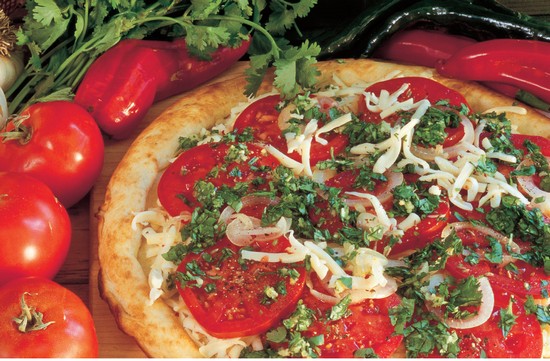
Tortilla chips and peppers come in many colors. This recipe is a variation on a tried-and-true restaurant dish.
For the salsa:
2 to 4 fresh serrano or jalapeño peppers
½ medium white onion, minced
2 cloves garlic, pressed or minced
4 large, ripe tomatoes, minced and seeded
3 tablespoons fresh minced cilantro
Salt to taste
For the nachos:
12 oz (340 g) corn tortilla chips (red or blue or a combination of both)
1 lb (450 g) of pepper Jack cheese, grated
1½ cups (180 g) roasted pepper strips, of all different colors
1 teaspoon ground cumin
Garnish: 2 tablespoons freshly chopped cilantro
To make the salsa: Stem the chilies (seed, too, if you desire a milder salsa) and then mince. Combine them with the remaining ingredients.
To make the nachos: Preheat the oven to 350°F (175°C). Place one layer of chips in a baking dish. Sprinkle with ⅓ each of the cheese, the pepper strips, and the cumin. Repeat with a second and third layer. Bake until the cheese has melted and started to brown, about 3 to 5 minutes. Watch carefully to avoid burning the chips. Garnish the nachos with the cilantro and serve with the salsa. Serves 4.
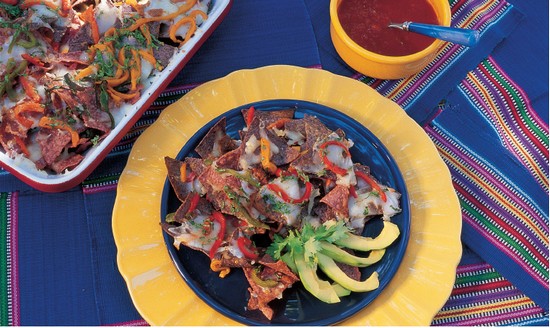
This “fragrantly” flavorful dish makes a wonderful accompaniment for fish or roasted chicken, or you can add grated cheese before you cover the rice with the bread-crumb mixture for a vegetarian main course. I prefer to use Carolina or Basmati rice as they have a light, rich texture.
2 cups (450 g) uncooked white long-grain rice
4½ cups (1.2 liters) vegetable broth, divided
1 bay leaf
2 Florence fennel bulbs (3–4 in/8–10 cm wide) with greens (approximately 2 lbs/1 kg)
2 tablespoons olive oil
1 large onion, coarsely chopped
2 garlic cloves, minced
1 teaspoon fennel seeds
1 teaspoon coriander seeds
2 tablespoons chopped fresh parsley
Salt and freshly ground black pepper to taste
1 cup (95 g) grated Gruyère cheese (optional)
1½ cups (75 g) fresh breadcrumbs
⅓ cup (30 g) chopped shelled pistachio nuts or shelled almonds
⅛ teaspoon freshly ground black pepper, plus extra
1 tablespoon butter, melted
Place the rice in a large saucepan or rice cooker. Add 3½ cups (875 ml) of the vegetable broth and the bay leaf. Bring it to a boil, then cover and cook over low heat for about 20 minutes, or until the rice is tender and the liquid has been absorbed. Remove the bay leaf.
Meanwhile, remove the fennel leaves from the stems, setting aside a few leaves for a garnish. Finely chop the leaves. Cut the fennel bulbs crosswise into fine dice.
In a large frying pan, heat the olive oil over medium heat. Add the onions, garlic, and diced fennel bulbs and sauté, stirring occasionally, for about 10 minutes, or until translucent.
With a blender or mortar and pestle, coarsely grind the fennel seeds and coriander seeds.
In a large bowl, combine the onion mixture, cooked rice, chopped fennel greens, parsley, and the ground coriander and fennel seeds. Add salt and pepper to taste. (At this point you could stir in the nuts and serve immediately as a simple side dish.)
Preheat the oven to 350°F (175°C). Grease a 3-quart (3-liter) shallow oven-proof casserole dish. Add the remaining vegetable broth to the rice and mix. Spread the rice mixture evenly in the dish. Sprinkle grated Gruyère cheese over the rice, if desired. In a small bowl, combine the breadcrumbs, nuts, and the ⅛ teaspoon of black pepper. Sprinkle the breadcrumb mixture over the rice. Drizzle melted butter on top. Bake for about 15 minutes, or until the top is a light golden brown. Serve garnished with fennel leaves. Serves 6.
